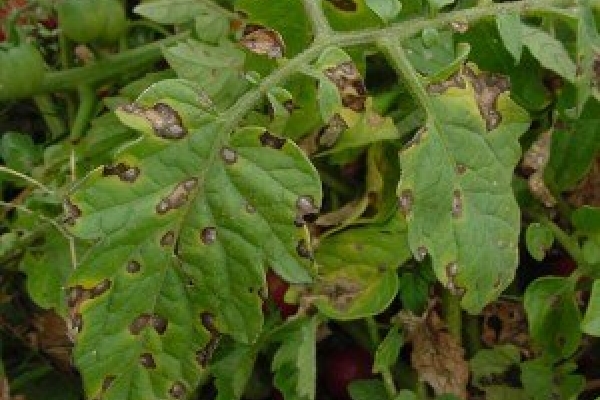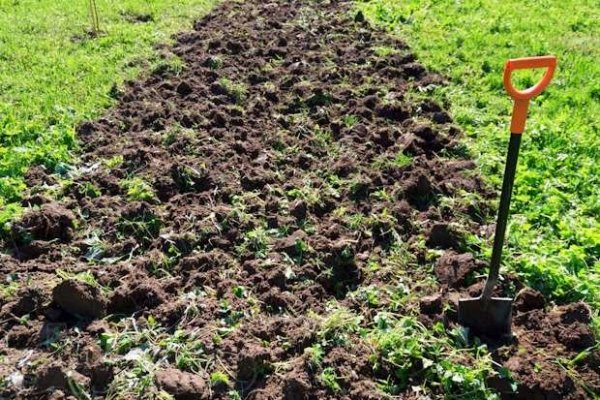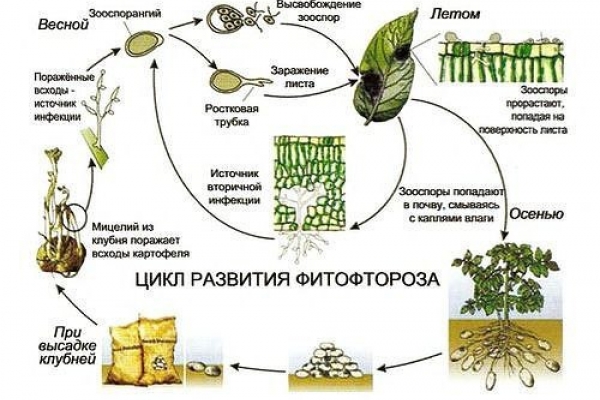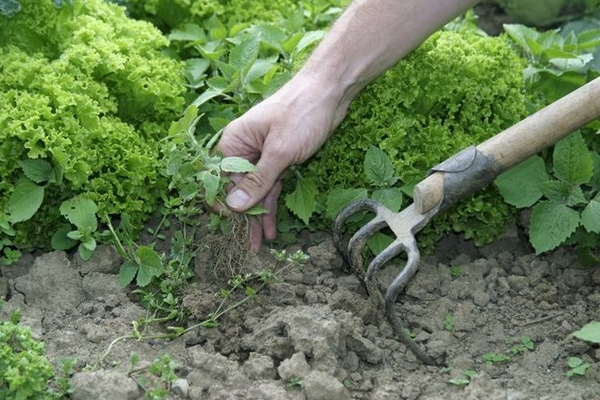How to cultivate the land infected with late blight
Content
From what appears
Plants with late blight are inflicted by oomycetes, which until recently were classified as fungi, and now they have been isolated as a separate group of special mycelial organisms. Phytophtora specializes in representatives of the nightshade, so potatoes, eggplants, tomatoes, peppers and physalis become their victims in the beds.
Oomycetes spend most of their life cycle in the phase of spores in the soil and in the remains of diseased plants. Only with the onset of favorable conditions do they move on to active life, the purpose of which is to leave offspring. When the air is warmed up to a temperature of +25 - +30 ° C, spores in dew drops are able to germinate and infect the plant within an hour.
 Phytophthora is especially active during sudden changes in daily temperature, when the daytime heat is replaced by rather cool nights, which contributes to frequent fogs and abundant dew. Frequent rains in late July and early August also contribute to its spread. But dry weather, as well as heat above +30 ° C or cooling to +10 ° C and below, lead to almost complete fading of the pest's vital processes.
Phytophthora is especially active during sudden changes in daily temperature, when the daytime heat is replaced by rather cool nights, which contributes to frequent fogs and abundant dew. Frequent rains in late July and early August also contribute to its spread. But dry weather, as well as heat above +30 ° C or cooling to +10 ° C and below, lead to almost complete fading of the pest's vital processes.
Phytophthora affects almost all parts of plants: gray-brown spots appear on leaves, fruits or stems. At the same time, in rainy weather, diseased plants rot, and in dry weather, they dry out and break. From them, the spores are washed into the ground, and are also actively carried around by drops of water and gusts of wind.
Penetrating quite deeply into the soil, phytophthora spores successfully endure winter frosts and in summer they again begin to attack nightshade crops. They can also overwinter quite safely in the remains of infected plants abandoned in the garden.
Is it dangerous for the harvest
At the initial stage, gray-brown spots form on the leaves of infected plants. Then the leaves turn brown and die off. The first late blight affects the leaves near the soil, and then the disease spreads upward. Juicy, not yet matured young shoots also suffer greatly from pests, on which dark brownish stripes are formed, which dry out in dry weather, and rot in wet weather. The tops and lateral processes of the shoots die off, and the inflorescences located on them turn black and dry out.
However, the most unpleasant thing for the gardener is the appearance of late blight spots on the fruits. First, brownish or gray-green spots appear on them, which grow both along the surface and inward. After this, the stage of hardening begins and decay begins. In the tubers of diseased potatoes, sunken gray spots form on the surface, and inside the reddish color, the affected tissues reach the center. With a strong infection of nightshade crops with this insidious pest, you can lose up to 80% of the crop.
How to treat
Unfortunately, at the moment there are no such effective chemical or biological preparations with which it would be possible to completely disinfect the territory from phytophthora.
The proposed substances can significantly suppress the development of pathogenic microorganisms, but the soil will not get rid of them completely. Also, there is no way to cure a plant after being affected by a disease.
In the fight against the pest, chemical preparations containing copper have proven themselves quite well. The easiest way is to shed the soil for planting nightshade crops with a 1 - 3% solution of copper sulfate, after which the site should be dug up and additionally treated with such a microbiological preparation as Fitosporin-M. You can also use the copper-containing fungicide Ordan.
It is quite common among gardeners that the introduction of chlorine is an effective way to combat this pest. However, it is unlikely that it will be possible to destroy the spores with this substance, but it will definitely be possible to harm the humus. Neither soil nor plants will benefit from this.
Chemicals not only suppress pathogenic microorganisms, but also harm the beneficial fungi found in the soil. In contrast to them, microbiological preparations act more selectively, since in their composition they contain colonies of microorganisms for which the pest spores serve as food. At the same time, the earth is not exposed to harmful influences.
To prevent late blight outbreaks, the use of such microbiological preparations as Fitosporin-M, Mikosan or "Shining" is effective. They should be applied three times throughout the summer. For the soil in those places where it is planned to plant flowers or strawberries, you can use Alirin, which is similar in composition and effect to Fitosporin. If these preparations are not available, then the soil can be treated with Bordeaux liquid.
Prophylaxis
It is very difficult to get rid of the phytophthora that has appeared on the site. However, carrying out preventive measures allows you to minimize its spread and harvest an excellent harvest. Since the main source of infection is the land, then the lion's share of the efforts is directed to it.
Fungicides and microbiological preparations are used to destroy the spores in the soil. Since chemicals take a long time to decompose, after they are added, vegetables can be used in food only after a month. Therefore, the treatment with copper-containing substances is carried out in early spring. The introduction of microbiological preparations into the soil is allowed at any time, except for the flowering period, when they can harm the bees collecting nectar.
From the soil, phytophthora spores enter the plants by means of moist air currents rising from the heated ground. In order to effectively prevent this process, mulching is used. Covering the ground with a layer of mulch several centimeters thick in spring becomes a reliable barrier against many diseases, the sources of which are the spores of pathogenic fungi wintering in the soil.
It is also important not to plant nightshade crops in the ground. In addition to the fact that the plants in this case lack light and are poorly ventilated, late blight will easily move through the beds and affect large areas.
Autumn harvesting and off-site incineration of all waste effectively helps to get rid of the spores remaining in the ground parts of the plants. After that, the soil should be dug deep.
A good result is the use of a drip irrigation system for plants. In this case, the soil is not waterlogged, and the plants receive the optimal amount of moisture for their growth and development. A good way of prevention is the use of crop rotation. Solanaceous plants in the same soil areas should be planted at intervals of three to four years.
Another option to avoid damage to plants by late blight is the cultivation of certain varieties of nightshade.These can be varieties that are especially resistant to the pest or early ripening, the ripening of which occurs at the time when the late blight begins to actively multiply.
Video "Treatment of ground tomatoes from late blight ”
On the record, a woman talks about the method of treating nightshade plants from a disease such as late blight.
